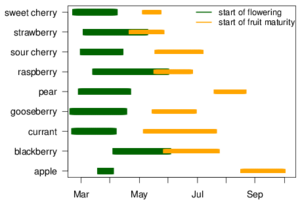Project C6 Poethke/Hovestadt
The evolutionary value of timing and timing precision in insect phenology
Summary
Molecular clocks play an important role in the timing of daily activities (like foraging) or seasonal (life history) decisions like pupation, eclosure, or reproduction. In our theory-orientated project we quantitatively investigate the fitness value of genetic and phenotypic components of properly timing decisions. Temporal (inter-annual) and spatial variance of environmental conditions (e.g. climate, host plant phenology) should obviously influence optimal emergence strategies - but due to intraspecific competition decisions should also depend on the timing strategies of others. Emergence of all individuals at the very same moment can thus typically not be a valid strategy: Spreading of risk, avoidance of competition with conspecifics, and unpredictable habitat heterogeneity should select for inter-individual variance in the timing of emergence. These factors will also influence the fitness value of precision in timing and thus the selective pressure on the accuracy of timing.
Our work is based on analytical approaches as well as individual based computer simulations of the dynamics emergence traits/strategies in insect populations. Such simulations readily allow quantifying the fitness value of different behavioural types and to simulate the evolution of timing strategies under different conditions. Input data for inter-annual variability of climatic conditions and on plant phenology will be derived from published long time climatic data series. The models can also be applied to the problem of timing daily activities like foraging where similar issues of uncertainty and avoidance of competition emerge.
We focus on the timing of spring emergence in three exemplary groups of insect species. We use honey bees (social insects), solitary bees (pollen collectors), and aphids (herbivores) as model systems for insect species that represent different positions concerning the influence of host plant phenology (either narrow or broad season) and intraspecific competition (either weak or strong) on fitness relevance of timing. Proper timing of emergence is pivotal for these species to e.g. synchronize their activity with the phenology of their host plant, or to avoid detrimental environmental conditions like periods of severe frost. It is known that, besides purely clock-based decisions (day length), threshold temperatures, accumulated temperature sums, or combinations of different cues may be used to control the moment of emergence. A main goal is to assess the suitability of various past and current environmental conditions as predictors for future conditions and thus the optimal moment of emergence.






